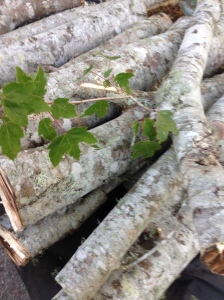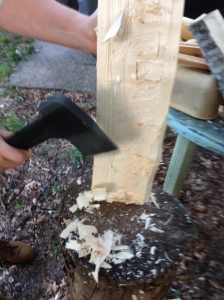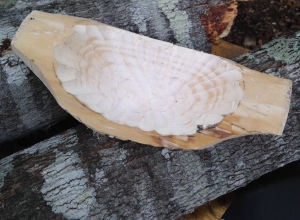
When I saw the maple tree being cut down, I couldn’t believe it.
This was a tree that I pass in my regular driving route, and I had admired the tree. There are not too many maples in this section of Florida, which has many more water oaks and pine trees.
This maple tree was in good health, with branches boasting healthy green leaves, and providing good shade in an otherwise open front yard.
I parked my car and asked the yard worker why he was cutting down the tree. He replied that was what he’d been hired to do.
As you might imagine, my next question was about what was going to be done with the wood. “Mulched,” he said.

I went home, changed into my woodworking clothes, got my saw and drove back.
Together, he and I cut the limbs and trunk into pieces. With each piece of the tree I could see spoons, bowls and knives evolving from the wood. He was glad to have my interest in helping with the wood, as it was an incredibly hot and humid day. I was looking forward to having such wonderful wood to work with.
I’d recently been part of an intense course on carving and creating wood bowls, knives and spoons. This wood was perfect for creating those kitchen items.
While I could readily see the tree was a maple, I had to wait to get home to my tree book to double-check and find out that it was a Red Maple.

I’ve been working on the wood when I have time, prepping it while it is still green. I’ve cut it into pieces. Some sections of the trunk can be split to create six spoon blanks. Other pieces are large enough to become turned or carved bowls. I’ve shaped out a few spoons and bowls with the axe. It’s a real workout in the humidity of a Florida summer.
The grain of this tree is wonderfully straight. The wood, after being debarked, is white and glistens with moisture.
I look forward to returning to the wood — hoping to keep it moist enough to allow me to carve more spoons and bowls.

I’d like to see your adze and the Doug’s device for holding the workpiece. Chris, from Lake City, makes dough bowls while holding the work piece with his left hand as he chops with his right. It scares me to death everytime I see him do it this way. My bowl adze too has a very short handle. I like the way it works, I just need more practice.
I found it on eBay several years ago and was sold to me by the guy that forged it. We talked on the phone a couple of times.
LikeLike
That’s cool, Don. I have a nifty wood holder for the wood that Doug Finkel gave me. He makes them for his middle school classes he teaches. Holds the bowl firm so your hands don’t need to be any where near the swinging adze. My adze has a short handle (traded a flute for it) and yes, it is sharp. I often use two hands to keep my fingers out of the way. Will have to show you this. You may want to make one if you carve another bowl.
LikeLike
Ah, Julia, if you only knew. I actually had put in a request to One-who-could-grant-it for some green wood just only the day before. It was a very quick answer!
LikeLiked by 1 person
Thanks for the vote of confidence, AB! If I get any done, I may need to bring you a sampling of the beautiful maple on my next visit!
LikeLike
I bet you would have done the same thing, Warren. I hear you’re building ingenious items yourself! 🙂
LikeLike
I bought a bowl adze a while back that was forged out of a claw hammer. It has an ideal shape for chopping out the interior of a bowl as is in your photos. It is VERY sharp! I keep a close eye when I am using it so I don’t accidently hit my hand.
LikeLike
I am so glad someone saved this beautiful wood from a chipper.
LikeLiked by 1 person
That maple surely was meant for you! I hate to see trees cut so it’s a consolation that the wood will go to such an artist as yourself.
LikeLiked by 1 person
Beautiful beginning to the story; am looking forward to hearing the rest of it unfold in all the beautiful finished creations.
LikeLiked by 1 person